Rare Collectibles Collectibles : Elephant Rare Collectibles
Showing some results we found...Click here to view all

Namiki Emperor Limited Edition Elephant 99pcs Box and Papers rare Maki-e
Click here for more information
CollectionHero
Find many great new & used options and get the best deals for Namiki Emperor Limited Edition Elephant 99pcs Box and Papers rare Maki-e at the best online prices at eBay! Free shipping for many products!
from CollectionHero
CollectionHero
12780.00
USD
2025-11-20
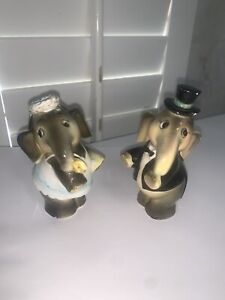
New ListingRare Norcrest Py Inspired Htf Japan ? Anthropomorphic Wedding Elephant Shakers
Click here for more information
CollectionHero
Rare Norcrest Py Inspired Hard To Find Japan Anthropomorphic Wedding Elephants Salt And Pepper Shakers. Shakers are about 3.5 inches tall. Shakers do contain chips and paint loss. Both tails are missing on elephants. Sold as is! See photos for details (Condition: Pre-Owned)
from CollectionHero
CollectionHero
7000.00
USD
2025-11-20
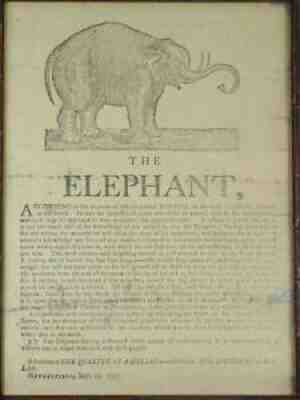
Rare Antique First Elephant In America Advertising Broadside Newburyport MA 1797
Click here for more information
CollectionHero
We are auctioning a fantastic collection of American folk art from the estate of a lifelong Americana dealer this week, please take a look! A wonderful rare original antique 18th century Newburyport, Massachusetts 'The Elephant' advertising broadside, dated to 1797. This fabulous original broadside is an advertisement to come to Newburyport and see the first elephant which was brought to the United States. The broadside has a large woodcut of the Indian elephant at the top with letterpress text and goes on to describe the characteristics and habits of the beast which includes its love of beer-
from CollectionHero
CollectionHero
6900.00
USD
2025-11-20
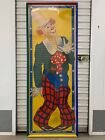
? RARE Antique Old French Paris CIRCUS Cirque d'Hiver Lithograph Poster, 1949
Click here for more information
CollectionHero
This is a fantastic, monumental and original RARE Antique Old French Paris CIRCUS Clown Cirque d'Hiver Lithograph Poster on paper, promoting La Menagerie des L'Arrivee du Cirque, held at the historic Cirque d'Hiver in Paris, France, for an exhibition in 1949. This vibrant and brightly colored lithographic poster depicts a near life-sized circus clown, wearing a tall felt hat and grinning with a wide jovial smile. At the bottom edge of the poster, it reads: "Location et Visite de La Menagerie des L'Arrivee du Cirque. Imp Aussel Paris. Mar 49 - 07." This very large exhibition poster is approximately 22 3/4 x 64 1/2 inches (including frame.) Actual visible artwork is approximately 22 5/8 x 62 5/8 inches. Over 2 x 5 feet! The colors of this artwork are still bright and vibrant, and it is clear that this poster has been kept out of direct sunlight for decades, which is rare with these types of posters. It is also mounted in a custom multicolored wooden frame of green, red, blue, and yellow, which complements the bold tones of the poster. Good condition for age, public display use, and size, with some moderate creasing in the corners, small creases throughout, and speckles of staining in the lower right corner (please see photos.) Due to the very large size of this piece, S&H costs will be unavoidably high. However, Free Local Pickup from Los Angeles, California is also an option. Acquired from an affluent private collection in San Fernando Valley. Priced to Sell. This particular poster is extremely scarce, and I cannot find another example for sale anywhere. Photo 24 depicts a similar poster by the same publisher, dated 1948, which is housed at the Museum of European and Mediterranean Civilizations (MuCEM) in Marseille, France. If you like what you see, I encourage you to make an Offer. Please check out my other listings for more wonderful and unique artworks History of the Cirque d'Hiver in Paris, France:Cirque Napoléon, Cirque National, Cirque d'HiverBy Dominique JandoLocated in the heart of Paris, between the Place de la République and the Place de la Bastille, at the edge of the historical Marais, the Cirque d’Hiver is the world’s oldest extant circus building. It is also the world’s oldest circus still in activity: It opened its doors in 1852. Its address, at 110 rue Amelot, may seem inconspicuous, but at that precise point, the rue Amelot opens onto the Boulevard du Temple through the small Place Pasdeloup: The Cirque d’Hiver is therefore quite noticeable, practically "on the Boulevards Louis Dejean’s CircusesThe Cirque d’Hiver (literally, the winter circus) was built for circus entrepreneur Louis Dejean (1786-1879) to serve as his circus company’s winter home. Dejean already managed the Cirque des Champs-Elysées in the fashionable Jardins des Champs Elysées which he kept open from May through October. Up to 1846, his main establishment had been the Cirque Olympique, located some five hundred yards from his new circus, on the portion of the Boulevard du Temple that disappeared in 1862, during the renovation of Paris by the Baron Haussmann, to give room to the present Place de la République Dejean had sold his old Cirque Olympique in 1847; although it had been built only twenty years earlier (in 1827), it had already lost its appeal and was not practical anymore. Like many circus buildings of its generation, it had been designed with both a circus ring and a full theater stage, and consequently, it was easy for its new owners to transform it into a legitimate theater, the Théâtre du Cirque Olympique. With no permanent home in the winter, Dejean had taken to sending his troupe abroad, to London or Berlin, for the winter season. Although these forays into foreign lands had proved successful enough, having a new winter base in Paris still made more sense.Thus, Dejean asked Jacques-Ignace Hittorff (1792-1867), the City of Paris’s Chief Architect, to design the plans for a new circus. Hittorf had already built the Cirque des Champs-Elysées for Dejean, as well as its twin counterpart, the Panorama (today Théâtre du Rond-Point), which were part of the master plan for the renovation of the Chanps-Elysées gardens in the 1840s. Hittorff had also supervised the redesign of the Place de la Concorde (notably with the addition of his own monumental fountain, La Fontaine des Mers) and he would later build Paris’s Gare du Nord, the twelve hôtels particuliers (townhouses) that surround the Arc de Triomphe on the Place de l'Étoile, and many other "classic revival" pieces of work—a style of which he was one of the most influential proponents.In the 1850s, on the area where the Place de la République stands today, the Boulevard du Temple arched and widened into a section that was popularly known as the Boulevard du Crime—for the many crimes committed onstage every night in the melodramas that were the main fare of the Boulevard’s numerous theaters. With its alignment of theaters, cafés chantants and other popular attractions, the Boulevard du Crime was the heart of Paris’s entertainment district, a favorite destination for Parisians and visitors alike.The piece of land Dejean was able to secure was situated at the eastern end of that section of the Boulevard du Temple, just before it became the Boulevard des Filles du Calvaire. Although the location looked like an afterthought in regard to the Boulevard du Crime itself, it was still a prime one. Yet the empty lot was far from ideal: it had very little depth, and was below street level. The place had to be leveled, and its lack of depth would prevent Hittorff from building the vast foyer that would have been expected for such a large amphitheater Hittorff’s New CircusNonetheless the circus Hittorff began to build on April 15, 1852 was spectacular in many ways. It was a regular icosagon (a twenty-sided polygon), 42 meters (138’6”) in diameter, with a cupola reaching 27.5 meters (90’8”) at its peak. Its architectural peculiarity was that, unlike other circuses built before it, there were no columns inside the amphitheater to support its cupola: the surrounding walls, 55 centimeters (1’8”) thick and 16.25 meters (53’7”) high were reinforced at each angle by internal and external pillars that helped absorb the cupola’s weight.Unlike the Cirque Olympique, Dejean’s new building was not equipped with a theater stage. Not that Dejean had shunned it: Hippodramas were extremely popular in the mid-nineteenth century in circuses as well as in circuses had a strong advantage over theaters since they could use both ring and stage for spectacular, action-filled, three dimensional equestrian dramas. But the neighboring playhouses, which didn’t want to see yet another circus building transformed into a competing theater, had requested that the new circus be built exclusively for equestrian a ring and no stage, like the Cirque des Champs Elysées—and Dejean had to yield to their wish in order to obtain his permit.The house could accommodate 3,900 spectators distributed on three concentric seating sections, with standing room in a small promenoir running around the periphery of the house, behind the last row of seats. The seating, which consisted originally of narrow benches covered with crimson velour, and with a stiff back support, was notoriously detail that chroniclers of the time never failed to mention. Today, the seats are conventional theater seats, and boxes have been added (in 1923) after the third row in the lower that have lowered the capacity to 1,800 seats—but the space between each row has remained unchanged, and is still limited: for all its glory, the Cirque d’Hiver has never been a comfortable house!The decoration of the house itself was indeed impressive. The most eye-catching element was (and fortunately, still is) the ceiling, inspired by the velaria used to protect the audience from the sun in Roman amphitheaters; its sheer size, as much as its rich ornamentation, makes it hard to miss—even today, in spite of the fact that its view as a whole is slightly obstructed by the lighting grid.At the periphery of the house, a series of twenty paintings by Félix-Joseph Barrias and Nicolas-Louis Gosse, telling the history of horsemanship, adorned each panel of the polygonal wall. These are not visible today: They have been masked in 1955, and are now awaiting restoration. (A few of them have unfortunately disappeared, and others have been badly damaged by more than a century of neglect.) The house was lit by twenty ornate gas chandeliers distributed on its periphery, and by another giant chandelier above the ring. The stables, with room for 52 horses, were located in a long rectangular building at the back of the house, with a courtyard opening Rue de Crussol (a street perpendicular to the Rue Amelot). The building’s second floor accommodated the dressing rooms, various workshops, and living quarters at one end. Like the house, the stables were lavishly decorated; they included a superb fountain adorned with a bas-relief by the sculptor Astyanax Scévola Bosio, which is still visible today.Outside, the façade displayed two friezes running on the circumference of the building, sculpted by Bosio, Francisque Joseph Duret (the author of the famous Saint-Michel fountain in Paris), Jean-Baptiste Guillaume, Eugène Lequesne, and Antoine Dantan—all artists of recognized talent and great reputation. The main frieze depicted the creation of the horse by Neptune, and its training by Minerva.Two equestrian statues framed the entrance: a seductive Amazon by James Pradier on the left (which is said to have been modeled after the famous equestrienne, Antoinette Lejars, and was the second version of a statue whose first version adorned the façade of the Cirque des Champs Eysées) and a Greek warrior by Duret and Bosio, on the right. Frieze and statues are still in evidence today, but the Victory holding a lantern, which originally topped the building, has long disappeared.The Cirque NapoléonWhen the new circus opened its doors on December 11, 1852, nine months only after the beginning of its construction, Louis-Napoléon Bonaparte, the nephew of the late Emperor Napoléon I, had just proclaimed himself Emperor of the French under the name of Napoléon III a few days earlier, on December 2.This political event, however, hadn’t come as a surprise. After the fall of Napoléon I in 1815, France had reverted to a disappointing monarchy, during which a nostalgic cult of Napoléon and the Empire had steadily grown into a popular in no small part by the numerous pantomimes and hippodramas to the glory of the Emperor staged at the Cirque Olympique, and repeated (on a smaller scale) by other circuses.After the abdication of King Louis-Philippe in 1848, the French Republic was proclaimed and Louis Napoléon back from years of exile in New York and London, had been elected its first President by a landslide. It then became obvious that the restoration of the Empire was lurking around the corner—and since its inception, the wily Dejean had called his new circus, Cirque Napoléon. And for his first official public appearance, the new Emperor himself inaugurated the circus that bore his name—or his uncle’s, for that matter.The Equestrian Director of the new Cirque Napoléon was Adolphe Franconi (1800-1855), heir to France’s first and foremost circus dynasty; its Régisseur (or Artistic Director) was Ferdinand Laloue; and its Equestrian Master, in charge of the all-important high school (dressage) presentations, was the most famous equestrian and riding master of the time, François Baucher. The opening program offered to the Emperor included, among other artists, the celebrated clown Jean-Baptiste Auriol; the beautiful ballerina on horseback Coralie Ducos; and the god of horsemanship himself, the great Baucher.On November 12, 1859, the Cirque Napoléon was the set of a historic event: The creation by a young French gymnast from Toulouse, Jules Léotard, of a new circus discipline, the flying trapeze. A marble plaque located just behind the curtain, on the right side of the ring entrance, still commemorates the event.In 1861, the Cirque Napoléon began hosting the Concerts populaires de musique classique (Popular Concerts of Classical Music), which were presented each Sunday at 2:00 pm under the baton of Jules Pasdeloup (1819-1887). His orchestra, the Concerts Pasdeloup, still exists to this day, and the little square in front of the Cirque d’Hiver, which opens the rue Amelot onto the Boulevard du Temple, has been named Place Pasdeloup after the popular conductor. The Sunday concerts remained a tradition until 1884.The Cirque d’HiverIn 1870, after the humiliating defeat of Sedan in the war opposing France to Prussia, the deposition of Napoleon III on September 4, and the proclamation of the second French Republic, Dejean felt it wise to rename his circus, Cirque National. He eventually retired two years later, in 1872, and his two circuses went under the management of Victor Franconi (1810-1897), Adolphe’s cousin, who had taught King Louis Philippe’s children to ride, and had been the Écuyer Privé (private riding master) of Napoléon III. In 1873, Victor Franconi, whose republican feelings seem to have been hazy at best, finally gave the circus its present title, Cirque d’Hiver (Winter Circus). (The Cirque des Champs Elysées which had been renamed Cirque de during the Empire, and then Cirque National des Champs-Elysées in 1870, became the Cirque d’Eté—the summer circus.) Franconi, and his son Charles (1844-1910), who would succeed him, were among the last tenants of the great equestrian circus tradition. But Europe was entering the industrial age, and the audience’s tastes were beginning to change.Indeed, the circus, too, was changing with the times; not that great horsemanship had completely lost its appeal, but gymnastics and physical exercises were enjoying a growing interest. Léotard was in: He had become the circus’s first international acrobatic star—and, thanks to his tight costume (to which his name would remain associated) revealing his athletic figure, he became also one of the first sex symbols in show business. And sadly, the likes of Baucher and the Franconis, who had been among the brightest stars of the French equestrian circus, were already on their way out Additionally the Cirque d’Hiver began to face serious competition. The American circus entrepreneur and former equestrian and clown, James Washington Myers (1823-1892), had built a circus in the neighborhood, Place du Château d’Eau (today's Place de la République): the Grand Cirque Américain. Inaugurated in December 1875, it hosted Myers’ shows until 1879. Myers, who brought a new style and new acts to the Parisian audience, was extremely successful. When he was touring, the occasional tenants of his building were generally foreign companies (mostly Italian), which also gave a taste of novelty. More importantly, in June 1875, the Belgian equestrian Ferdinand Beert (1835-1902), known as Fernando, had opened a new circus on the Boulevard de Rochechouart, at the foot of the Montmartre hill, the Cirque Fernando (which would become later, in 1897, the legendary Cirque Medrano). Then, in February 1886, the entrepreneur Joseph Oller opened the Nouveau Cirque (Paris), rue Saint Honoré—a very elegant and comfortable circus, equipped with a state of the art ring that could be lowered by a hydraulic system to reveal a water basin.While the Franconis maintained the old equestrian tradition in their two Parisian circuses, Fernando offered its popular audience a lighter fare, whose main attraction was the clown Geronimo Medrano, known as "Boum-Boum." Medrano was often the star of amusing topical revues written especially for him, while the Nouveau Cirque specialized in joyous water would soon feature in them two clowns who were to become the toasts of Paris, Foottit & Chocolat. The Buffalo Bill’s Wild West also visited Paris in 1889, and so did the giant American circus Barnum & Bailey at the end of 1901. In the midst of all these novelties, the Cirque d’Hiver, staunch defender of the classical equestrian tradition, was increasingly becoming passé.In the last decade of the century, Charles Franconi, following the lead of Fernando and the Nouveau Cirque, produced a series of pantomimes, old and new, in the ring of the Cirque d’Hiver. Some were successful, but still, Fernando and the Nouveau Cirque had become the circuses of choice for the a mostly popular and bohemian audience for Fernando, while the Nouveau Cirque catered to the elegant clientele that, before, had frequented the Cirque d’Eté. In 1899, just two years after the death of his father, Charles Franconi had to close his summer circus on the Champs Elysées; he concentrated his efforts on maintaining the Cirque d’Hiver alive and profitable.The Cirque d’Hiver In The DarkBut in spite of often interesting programs, the Cirque d’Hiver had lost its appeal. The dignified Place de la République, which had replaced the lively Boulevard du Crime, worked as a buffer between the theater district on the west side, and the short section of the Boulevard du Temple on the other side, where the Cirque d’Hiver stood alone, isolated from the bright life of the west-side "Boulevards." Finally, at the end of 1907, Franconi and his shareholders leased the Cirque d’Hiver to movie producer Serge Sandberg (1879-1981), who transformed it into a movie house for the Pathé Company. Charles Franconi didn’t survive this disgrace very long; he passed away three years later, in 1910. A projection booth was built above the seats of the third section, facing the artists’ entrance—in front of which a movie screen had been erected—and the chandeliers disappeared. Obviously, a large part of the house could not have a good view of the screen. If only for its shape, not to mention its lack of comfort, the Cirque d’Hiver was not a very good movie house, especially as the movie audience was becoming more sophisticated In 1917, Sandberg transformed for a time the Cirque d’Hiver into a theater. The great French actor Firmin Gémier (1869-1933), who was developing a non-elitist, popular theater of quality with mass appeal, used the place for spectacular productions, such as a French version of Œdipe, Roi de in the footsteps of Max Reinhardt’s own extravagant spectacle, Oedipus Rex (1910), which the German director had produced at Circus Schumann in Berlin, and which had become an international sensation. Gémier's theater experiment at the Cirque d’Hiver was the forerunner of the Théâtre National Populaire (TNP), which he created after WWI, in 1920.Then, the Cirque d’Hiver reverted to the movies, with the same mediocre success. Finally, in 1923, Serge Sandberg sold his lease to a theater entrepreneur named Gaston Desprez. Desprez came from a family of industrialists; he had developed equipment for the French Army during WWI, but his true passion was show business. He had already purchased movie houses in several provincial cities, managed a theater, and produced a circus show at the municipal circus of Troyes (whose building is still extent), in the Champagne region. His two younger brothers, Marcel and André, shared his interests and had developed successful thrill acts for the circus.Back to The Circus: Gaston DesprezFrom the outset, Desprez announced his intention to give back the Cirque d’Hiver to circus arts, and his first move was to restore the building to its former glory. It had been carelessly modified during its years as a movie house and a theater, and was not suited anymore for circus performances: The ring, for one, as well as the stables, had disappeared. The architect put in charge of the project was Louis Gagey. The rehabilitation work lasted only three months, but was nonetheless extensive.The internal structure was reinforced, especially the structure supporting the seating, which had been built in wood and was not in a very good shape; it was replaced by a support made of concrete. The seating itself was entirely refurbished with modern theater armchairs, and a row of boxes was installed behind the third row of seats in the lower section; it made the circus a little more comfortable, although the space between each row of seats was still limited. The house was repainted and redecorated, with notably a beautiful series of gilded winged horses, recovered from the short-lived (1866-1867) Cirque du Prince Impérial on the neighboring rue de Malte; they were placed above the audience entrances to the house—and are still there today. Backstage, the stables were reinstated in one aisle of their original building, and the other aisle was transformed into a vast foyer for the audience, decorated as a winter garden, with a fountain (which has since been removed) in the middle. In 1924, a painted frieze picturing all the acts that had been seen at the Cirque d’Hiver during the first Desprez season (1923-1924) was installed at the top of the foyer’s walls. It is still visible today. Among its subjects, a likeness of Charlie Chaplin is often seen as a tribute to the building’s past as a movie house; it is actually a picture of Charlie Rivel impersonating Chaplin’s Tramp character in Rivel’s trapeze act, Charlie and the Rivels.The new Cirque d’Hiver opened its doors on October 12, 1923. The former equestrian acrobat and clown Louis Lavata was the Régisseur de Piste (Equestrian Director), and Pierre Blondeau, Desprez’s future son-in-law and right-hand man, managed the front of the house. (Blondeau would later run a talent agency.)When Desprez entered the arena, circus and variety were enjoying an unprecedented vogue in Paris—and the competition was fierce. Boulevard de Rochechouart, the Cirque Medrano had become more popular than ever, thanks in large part to the extraordinary success of a superlative trio of clowns, the Fratellinis. To be sure, the quickly aging Nouveau Cirque, rue St. Honoré, was reaching the end of its life (it would close in 1926), and the giant Cirque de Paris, opened in 1906 Avenue de la Motte-Piquet, was not faring much better (victim of its sheer size, it would close in 1930).However, the Empire theater, which called itself "Music-Hall Cirque" and opened in 1924 with a mixture of variety and classical circus—on the model of the Winter Garten and the Scala in Berlin—became an immediate hit, and great circus acts regularly starred at the Folies-Bergère and the Casino de Paris, Paris’s legendary revue theaters, and in music-halls (variety theatres) such as the Olympia, the Alhambra, and Bobino Fortunately Desprez saw big. He hired the best acts of the moment, including his brothers Marcel and André with their amazing double somersault in by the stoic daredevil André, and especially built by Marcel, who was an engineer. In September 1924, Desprez scored a remarkable coup: Rodolphe Bonten, Cirque Medrano’s director, had foolishly denied the Fratellinis a salary increase for the new season; Desprez immediately lured them to the Cirque d’Hiver at their conditions, and named them Artistic Directors, a title more honorific than real, but which was clever advertising.For the winter season of 1926, Pierre Blondeau signed and brought from the United States one of the most celebrated circus acts of all times, The Codonas, with the legendary triple somersaulter Alfredo Codona. This was indeed another coup: the flying trapeze’s brightest star in the circus where Léotard had invented the specialty! It definitely re-established Desprez’s Cirque d’Hiver as one of Europe’s premier variety houses, a circus to contend with. (The Codonas would return Rue Amelot in 1930.) Then, in 1927, the Cirque d’Hiver hosted for the first time the Gala de l’Union des Artistes, the original "circus of the stars" and Paris’s most prestigious gala benefit, which had been held previously at the Nouveau Cirque. This tradition would continue until 1974. (It was resumed once, in 2010, in an unsuccessful attempt to revive its tradition.)The Return of Circus PantomimesIn 1931, Desprez resumed the Cirque d’Hiver’s long tradition of circus pantomimes, taking his cue from Berlin’s Circus Busch, where the genre was flourishing with considerable success under the management of Paula Busch. The first of these spectacles was La chasse à courre ("The Dear Hunting"), a musical and equestrian piece, replete with horses, hounds, dears, and the Fratellinis, and featuring an interesting painted scrim surrounding the ring, which served as a set. A string of successful pantomimes would follow. In the spring of 1932, Desprez launched an itinerant version of the "Cirque d’Hiver de Paris," which began touring the French provinces under a big top during the spring and summer season. Then, in November 1932, the Cirque d’Hiver hosted one of the famous water pantomimes of the other, itinerant Circus Busch (also known as Circus Busch Nürnberg) Les nuits du Kalifat ("The Caliph’s Nights"), with an elaborate piece of equipment that transformed the ring into a water basin—albeit a rather shallow one. Les nuits du Kalifat was the forerunner of the spectacular water pantomimes that would make, in the years to come, the reputation of the Cirque d’Hiver Lavish water pantomimes, which had been the trademark of Paris’s Nouveau Cirque, had been equally popular at Moscow’s Circus Nikitin, and at Blackpool’s Tower Circus each summer in England, and they were especially successful at Berlin’s Circus Busch. These circuses had all been equipped with a ring that could be lowered to reveal a water basin, and Desprez decided to install such a ring at the Cirque d’Hiver. Once more, he asked the architect Louis Gagey to design the plans for the new sinking ring and its water basin, while the technological aspect of the work was entrusted to the Castiglione engineering company.The extensive work was completed in only one month. The basin, built of concrete, was 4.20 meters deep (about 14 feet), with a twenty-ton (metric) ring floor that could be lowered by a hydraulic elevator system; for this operation, the ring's heavy coco mat was removed, and the water passed through slots in the floor, as in the original system used before at the Nouveau Cirque. Openings in the basin's wall gave underwater access to the pool. The Cirque d’Hiver’s piste nautique (nautical ring) was inaugurated in November 1933 by the legendary meneuse de revue, Mistinguett (1875-1966), then France’s greatest variety star.The water basin was not the only improvement Desprez brought to the Cirque d’Hiver for the 1933-1934 season: A small stage was added above the ring could be connected to the ring with a removable staircase—and electric installations were modernized (with notably the addition of a crown of powerful lights under the cupola, and underwater lighting for the water basin). Finally, a roof was built over the Rue Amelot courtyard, which would allow, among other uses, proper housing for exotic animals when needed.The first "water pantomime" to use the new installations was Tarzan, a French adaptation of a Circus Busch’s original, with all the necessary equipment, set and costumes imported from Berlin. It lasted only one day: Unfortunately, Desprez had "forgotten" to secure the rights to the famous character created and closely protected by Edgar Rice Burrows... Elements of the show were hastily re-adapted by director Géo Sandry as a vehicle for the Fratellinis, Les Fratellini en Afrique ("The Fratellinis In Africa"), which didn’t fare very well.Les Fratellini detectives, which followed, was not more successful. The summer tours of the Cirque d’Hiver big top, even after Desprez re-named it Cirque Fratellini in 1933, had lost money. The new water basin and other renovations were still to be paid, and the recent productions had not recouped their costs. Maxime Morin, the President of the Société du Cirque d’Hiver (which had replaced Franconi’s Société des deux cirques) decided to terminate Desprez’s lease at the end of the season, and to offer the circus to the highest bidder.Enter The Bouglione FamilyThe brothers Amar, whose traveling circus was one of France’s most prestigious, and who played Paris in the winter under a wood and canvas structure (known in French circus lingo as a semi construction) began negotiating a lease. But they were quickly outdone by the Bouglione family, their main competitors who, like them, had debuted in the traveling menagerie business. The Bougliones accepted to assume the debt incurred by the recent renovation of the circus, which the Amars had been reluctant to include in the deal. The Bougliones were a family of Sinti Gypsies. They had made their fortune with a successful hoax: After having purchased an old stock of unused posters for the 1905 French tour of the Buffalo Bill’s Wild West, they had launched a colorful, if suspicious, Stade Buffalo-Bill in 1924. In spite of a very European circus program, they had managed to lure under its big top Belgian and then French provincial audiences, who were apparently content with a lively and rather exotic atmosphere (certainly owing more to the Bougliones’ vibrant Gypsy blood than to the American West) and a makeshift "Wild West" presentation at the end of the show.In 1928, the Stade Buffalo-Bill hit Paris; although the savvy Parisian circus and variety critics and a large part of the audience were not fooled, the Bougliones met with the same success in the capital as they had in the provinces. But the deception couldn’t last forever, and the following season, they abandoned Buffalo-Bill and began touring under a variety of names, before settling to their own in 1933: Cirque des 4 Frères Bouglione.Their sudden arrival onto the Parisian circus scene, however, was the result of a quarrel with the brothers Amar over the acquisition a large group of elephants from the recently bankrupted Czech Circus Kludsky, in which the Amars had finally outsmarted the Bougliones. The Bougliones took their revenge in derailing the Amars’ deal with the Société du Cirque d’Hiver. As the late Joseph Bouglione once told this writer, "We didn’t know really what to do with [the Cirque d’Hiver]: We had never had a sedentary life before; but it was a victory, and it was an opportunity Indeed the Bouglione brothers (Alexandre, 1900-1954; Joseph, 1904-1987; Firmin, 1905-1980; Sampion, 1910-1967) seized the opportunity: More than eighty years later, the Bouglione family still owns and exploits the Cirque d’Hiver. Instead of just getting a lease on the circus, they made a deal with Maxime Morin, and became partners with him in the ownership of the old Cirque d’Hiver company. In time, the company would change names, and the Bougliones eventually remained its sole shareholders The Bougliones reopened the Cirque d’Hiver on November 17, 1934. The house had been repainted and refurbished afresh, and the opening had been preceded by a street parade, as the Bougliones used to do when they toured the provinces under canvas. Not to be outdone by the Amars, the parade displayed an important herd of elephants that included the Bougliones’ two pachyderms, three more borrowed to the Jardin zoological garden in Paris, and a group from Circus Althoff in Germany. Smart advertising indeed, since the most distinctive element the Bougliones were bringing to the Cirque d’Hiver was their important menagerie of exotic animals.In January 1935, the Bougliones staged their first pantomime, La reine de la Sierra ("The Queen Of The Sierra"), which began a long string of extravagant, often exotic spectaculars that included songs, music, wild animals, water frolics, and a cast of actors, singers, dancers, clowns, acrobats, and animal trainers supported by the extended Bouglione family. These spectacles were conceived by the prolific director Géo Sandry, and for them, ring, stage, and water basin were used at their fullest. For the 1935-1936 Holiday season, Géo Sandry produced what would remain the masterpiece of the genre—and a Bouglione staple until the 1960s—La perle du Bengale.During WWII, and the German occupation of Paris (1940-1944), the Cirque d’Hiver reverted to simpler productions that mixed circus and variety, until the German occupants gave the management of the two Parisian circuses, the Cirque d’Hiver and Medrano, to Paula Busch and her son-in-law, the producer Emil Wacker, who had lost their circus in Berlin to city planning. They took possession of the Cirque d’Hiver on December 15, 1940. It was just a futile attempt at improving Franco-German relations through the Bougliones were soon allowed to repossess their circus, which reopened under their management on March 22, 1941. They continued to exploit it during the War with programs that mixed circus (with pantomimes that starred the clowns Alex & Zavatta), variety, and sport exhibitions.The Post-War EraThe immediate post-war years translated into a boon for the circus industry throughout Europe. The Bougliones (who still toured with their Cirque Bouglione during the summer months, participated in other circus ventures, and rented out some of their animals to other circuses), took good advantage of the windfall. The Cirque d’Hiver was more prosperous than ever; the production of lavish pantomimes had resumed with considerable success, some of them serving as a comic vehicle for Achille Zavatta, who was well on his way to stardom.In 1946, the Cirque d’Hiver was once again renovated, notably with a significant enlargement of the stage above the ring the building of a large stage frame, in a style more reminiscent of the 1930s than of the Second Empire. In 1955, the Cirque d’Hiver’s menagerie itself became an important draw as the Bougliones acquired a widely advertised adult gorilla named "Jacky." That same year, the circus became the setting for Carol Reed’s movie classic, Trapeze (1956), starring Burt Lancaster (who was a former circus acrobat), Tony Curtis, and Gina was doubled in aerial sequences by Sandrine Bouglione. (It is for this occasion that the deteriorating paintings by Barrias and Gosse on the peripheral walls were covered by decorative elements and disappeared from public view.) Released the following year, Trapeze was an international success, and indeed an extraordinary advertisement for the Cirque d’Hiver. It is today an interesting documentary on the venerable Parisian circus at that time.The last original pantomime produced at the Cirque d’Hiver (in 1958) was Davy Crockett et Jimmy Boy, which surfed on the wave of Disney’s international movie hit, Davy Crockett, King Of The Wild Frontier (1955). Afterwards, only a few scattered revivals of La perle du Bengale, in different shapes, lengths, and under various names, just served as a reminder of a long tradition that was now vanishing.From 1954 to 1978, the Cirque d’Hiver hosted the long-running, monthly television show, La Piste aux Etoiles, which made the Parisian building familiar to anyone in France who had a TV set. The Cirque d'Hiver also continued to host annually the Gala de l’Union des Artistes until 1974, and the Gala de la Piste, with a few interruptions, between 1959 and 1980. In 1977, and from 1988 to 2006, the Festival Mondial du Cirque de Demain was also held for one week each year at the Cirque d’Hiver.In 1981, French TV personality Yves Mourousi (1942-1998) produced the Mark Bramble, Michael Stewart and Cy Coleman's hit Broadway musical, Barnum, at the Cirque d’Hiver. For the occasion, the circus underwent again a series of renovations, notably the addition of new chandeliers above the second tier of seats on the periphery of the house, designed after the originals that had disappeared when the circus was transformed into a movie theater. The project included the restoration of the cupola decoration, the installation of a lighting grid, and the refurbishing of the circus’s corridors with marble floors. These improvements were paid for by the City of Paris—which compensated largely for the failure of the musical.That event, however, opened new perspectives to the Bougliones. Since the 1960s, the Cirque d’Hiver had performed only three days a week and on holidays. Joseph Bouglione, the last of the original brothers was aging (he would pass away in 1987), and his sons, Sampion (b.1938), Emilien (b.1934), and Joseph (b.1942), had already ceased the tours of the once mighty Cirque Bouglione. As for Joseph’s elder, Firmin (b. 1932), he had left the family's enterprise and established his own Cirque Bouglione in Belgium. The circus scene was changing; the Cirque d’Hiver had trouble adapting to a new era, and was running out of steam.The RenaissanceIn 1984, the Cirque d’Hiver became a house for hire, and began hosting a series of theatrical production, recitals, fashion shows, etc., with only a few incursions back into the circus world. From 1986 to 2007, the Festival Mondial du Cirque de Demain occupied the ring for one week every year, and the burgeoning Cirque du Soleil performed there for one month in 1990. In 1997, Muriel Hermine, former Synchronized Swimming European champion, created and starred in Crescend’O, an aquatic show directed by Guy Caron, for which the old water basin, practically idle since the War, had been completely rebuilt.Then in 1998, the new generation met with the then family patriarch, Sampion Bouglione II (1938-2019): His son, Francesco, and his nephews, Joseph Junior, Louis-Sampion, Regina, Thierry, and Nicolas, expressed their will to resume a circus season at the Cirque d’Hiver. Circus was back; several young Bougliones had performed in other circuses and varieté shows all around Europe, and they were well aware of the success of circuses that were defining new trends in the way of presenting circus performances. They wanted to be part of this circus renaissance After a few renovations, notably of the ring, which had slowly lost the characteristics of a true circus ring from one theatrical production to another, the Cirque d’Hiver reopened its doors as a full-fledged circus on October 1999, with a circus production titled Salto. Brilliantly cast, staged, lit, and costumed, accompanied by a superb orchestra, and with the participation of a seductive group of girl dancers (who would become known in following productions as the Salto Dancers and eventually reinforced with a couple of male dancers), the show was an immediate and unmitigated success. Since Salto, a new production has graced the ring of the Cirque d'Hiver each year from October through March, meeting each time with increasing success. And in 2002, the production titled Le Cirque celebrated brilliantly the 150th anniversary of the Cirque d'Hiver.In the summer of 2008, The Cirque d'Hiver's façade underwent an extensive restoration: vanished decorative elements were rebuilt; the friezes, which had been damaged over the years, were repaired; and so were the equestrian statues, external lights, stained glass windows, etc. The building's original colors were reinstated, and the painted frieze in the foyer was restored; the vibrancy of its original colors, muted by years of exposition to cigarette smoke, became visible again. Other restoration work, notably of the murals inside the house (which are badly damaged and have been hidden from view since the 1950s) is planned.Today under the efficient management of Odette Bouglione, a daughter of the patriarch Émilien Bouglione, and the artistic direction of Joseph Bouglione, Jr., and after more than 150 years, the Cirque d’Hiver de Paris is younger than ever. (Condition: Pre-Owned)
from CollectionHero
CollectionHero
6500.00
USD
2025-11-20
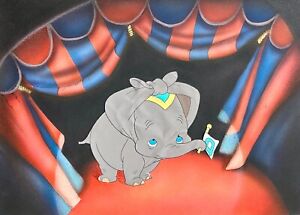
1941 RARE WALT DISNEY DUMBO COURVOISIER ORIGINAL PRODUCTION ANIMATION CEL
Click here for more information
CollectionHero
eBay DUMBO PRODUCTION CELWALT DISNEY STUDIOSGOUACHE ON CEL, 1941 Description: Original hand painted and hand inked production animation cel of Dumbo set over a Courvoisier air brush background from "Dumbo," 1941, Walt Disney Studios; With original Courvoisier Galleries certificate; Unframed. "And now, I present to you the world's smallest little elephant, who will spring from this springboard in one spring to the top of the pyramid, waving his little flag for the grand climax! Ladies and gentlemen, I give you... Dumbo!" ? RingmasterThe Walt Disney full length feature film "Dumbo," released in 1940, introduced to the world one of the greatest characters in the Disney pantheon, Dumbo the flying elephant! Dumbo was the only character in the film who never uttered a single word, and yet he is one of the most remembered Disney stars. All of his feelings were conveyed through body movements and facial expressions. The extraordinary animation skill needed in order to do this with a human, but in this case a baby elephant, can not be underestimated The Disney Studio animation artists were still fairly new to feature animation, having only started in 1937 with "Snow White and the Seven Dwarfs." The film prior to "Dumbo" was "Fantasia," with one of the most successful sequences being "Night on Bald Mountain." Here again, the main character Chernabog, a huge winged devil, sitting on top of a mountain, commanding the undead below, and never uttering a single word; made a huge impression on the viewing public.The Disney animator Vladimir "Bill" Tytla created the devil-giant for "Fantasia's" "Night on Bald Mountain," and for the next film he was given the task of animated the film's star, Dumbo. He said: "I gave him everything I thought he should have," said Tytla. "It just happened. I don't know a damn thing about elephants. It wasn't that. I was thinking in terms of humans, and I saw a chance to do a chracter without using any cheap theatrics. Most of the expressions and mannerisms I got from my own kid. There's nothing theatrical about a two-year-old kid. They're real and sincere- like when they damn near wet their pants from excitement when you come home at night. I've bawled my kid out for pestering me when I'm reading or something, and he doesn't know what to make of it. He'll just stand there and maybe grab my hand and cry... I tried to put all those things in Dumbo Certainly the greatest theme of "Dumbo" was the wonderful friendship between the mute baby elephant Dumbo and his unlikely friend, a mouse name Timothy. Various Disney animators were involved with the creation and animation of Timothy Q. Mouse including Fred Moore, Wolfgang Reitherman, and Ward Kimball. Edward S. Brophy was an American character actor, voice artist, and comedian; and he provided the voice for Timothy Mouse even though he was not credited in the film for the role.In fact, none of the voice actors for Dumbo received screen credit. The pompous matriarch of the elephants was voiced by Verna Felton, who also voiced the Fairy Godmother in "Cinderella," the Queen of Hearts in "Alice in Wonderland," and Flora in "Sleeping Beauty." Other voice actors include Sterling Holloway as Mr. Stork, Cliff Edwards (better known as the voice of Jiminy Cricket) as Jim Crow, and John McLeish (best known for narrating the Goofy "How To" cartoons) providing the opening sequence narration.This cel is from the scene in the film when Dumbo, the world's smallest elephant, is suppose to run out into the center ring and jump onto a string board that would catapult him high into the air, and landing on a small platform atop a pyramid of seven elephants. When the curtain opens and Dumbo hears the laughter of the audience he slowly begins to back up, and Timothy Mouse pricks him with a pin in order to get him to run towards the spring board. As Dumbo is running his ears, that were tied loosely atop his head, unravel and he trips; causing him to miss the spring board platform and instead hit the rubber ball that was supporting the pachyderm pyramid. This is a wonderful full figure, eyes open production cel of Dumbo from the beginning of the sequence; and would be a great addition to any vintage Walt Disney animation art collection! - Dumbo: 4 3/4 x 5 3/4", Image 9 x 12 1/2"Certificate of Authenticity Money Back Guarantee:A full color Certificate of Authenticity and written Money-Back Guarantee is provided for this lot, Satisfaction Guaranteed! Condition: See pictures of the actual cel which is in excellent overall condition as shown above! All items we sell are from a smoke free mold free home/workplace and are in excellent condition unless otherwise noted. About Me: I am a private collector and dealer of both Fine Art and Original Production Animation Art Work with over 20 years of experience; with the on-line site Untitled Art Gallery. I own every work pictured for sale and I stand behind every item. Please follow/bookmark me as a favorite and keep checking back for more items for sale in the coming weeks. For now, please check out my other Animation Drawings and Cels and other original modern and contemporary artwork for sale! Shipping: This work of art is located in and can be picked up in Durham, NC, 27713. Buyer to pay for ALL costs related to shipping within the US and Worldwide if you choose to not pick this work of art up yourself. Payment: I accept PayPal. TO TAKE A LOOK AT MY OTHER ITEMS FOR SALE, PLEASE CLICK HERE (Condition: Pre-Owned)
from CollectionHero
CollectionHero
6000.00
USD
2025-11-20

Randall Made Knives "African Big Five" Limited Edition 5x Hunting Knife Set Rare
Click here for more information
CollectionHero
Maker: Randall Made KnivesModel: "African Big Five" Limited Edition 5x Hunting Knife Set, Only 50-100 Sets Ever Ron. E. SkaggsQuantity: 5x Knives With Sheaths and CasesLeopard: The Leopard knife is a Model #27 "Trailblazer". It has a 5 3/4'' blade, and is 10 1/2'' long overall. It features stacked leather washers at each end of the white micarta handle, black fiber and aluminum spacers, a nickel silver half guard, and a duralumin pommel. The beautifully scrimshawed leopard at the right side of the handle was executed by renowned scrimshander Ron E. Skaggs. The correct Randall Sheath was custom made by Sullivans of Tampa, Florida of Ostrich leather. Condition: Knife is in Very Good Plus Condition with little to no storage wear, blade is sharp with no dings or chips, tip is present and straight, handle is firm, blade is straight. Sheath has some small scuffs and scratches from storage wear, securing strap has been stored in the open position. Comes in the original "AFRICAN BIG FIVE" marked Randall zippered and padded case.Elephant: The Elephant knife is a Model #3 "Hunter". It has a 5'' blade, and is 9 1/2'' long overall. It features a white micarta handle, black fiber and aluminum spacers, a nickel silver half guard, and a duralumin pommel. The beautifully scrimshawed elephant at the right side of the handle was executed by renowned scrimshander Ron E. Skaggs. The correct Randall Sheath was custom made by Sullivans of Tampa, Florida of Crocodile leather. Condition: Knife is in Very Good Plus Condition with little to no storage wear, blade is sharp with no dings or chips, tip is present and straight, handle is firm, blade is straight. There is a mark on the guard, and some light markings on the handle. Sheath has some small scuffs and scratches from storage wear, securing strap has been stored in the open position. Comes in the original "AFRICAN BIG FIVE" marked Randall zippered and padded case.African Buffalo: The Buffalo knife is a Model #12 "Little Bear Bowie". It has a 6'' blade, and is 10 1/2'' long overall. It carries thumb grip "jimping" along the lower blade spine. It features a white micarta handle, black fiber and aluminum spacers, a nickel silver half guard, and a duralumin pommel. The beautifully scrimshawed African buffalo at the right side of the handle was executed by renowned scrimshander Ron E. Skaggs. The correct Randall Sheath was custom made by Sullivans of Tampa, Florida of Buffalo leather. Condition: Knife is in Very Good Plus Condition with little to no storage wear, blade and top edge are sharp with no dings or chips, tip is present and straight, handle is firm, blade is straight. Sheath has some small scuffs from storage wear, securing strap has been stored in the open position. Comes in the original "AFRICAN BIG FIVE" marked Randall zippered and padded case Rhinoceros: The Rhino knife is a Model #23 "Gamemaster". It has a 4 3/8'' blade, and is 9'' long overall. It carries thumb grip "jimping" along the lower blade spine. It features a white micarta handle, black fiber and aluminum spacers, a nickel silver half guard, and a duralumin pommel. The beautifully scrimshawed rhinoceros at the right side of the handle was executed by renowned scrimshander Ron E. Skaggs. The correct Randall Sheath was custom made by Sullivans of Tampa, Florida of Zebra hide. Condition: Knife is in Very Good Plus Condition with little to no storage wear, blade and top edge are sharp with no dings or chips, tip is present and straight, handle is firm, blade is straight. Sheath has one small scuff from storage wear, securing strap has been stored in the open position. Comes in the original "AFRICAN BIG FIVE" marked Randall zippered and padded case.Lion: The Lion knife is a Model #25 "Trapper". It has a 5'' blade, and is 9 1/2'' long overall. It features stacked leather washers at each end of the white micarta handle, black fiber and aluminum spacers, a nickel silver half guard, and a duralumin pommel. The beautifully scrimshawed lion at the right side of the handle was executed by renowned scrimshander Ron E. Skaggs. The correct Randall Sheath was custom made by Sullivans of Tampa, Florida of Crocodile leather. Condition: Knife is in Very Good Plus Condition with little to no storage wear, blade is sharp with no dings or chips, tip is present and straight, handle is firm, blade is straight. Sheath has some small scuffs and scratches from storage wear, securing strap has been stored in the open position. Comes in the original "AFRICAN BIG FIVE" marked Randall zippered and padded case.Markings: All knives are stamped on the lower left side of blade with the maker, "RANDALL MADE / ORLANDO, FLA.", along with "S" for Stainless Steel, and carry "AFRICAN BIG FIVE" marked along the lower right side.Please see our detailed pictures for additional information on markings.About the Randall "African Big Five" Knife Set: The Big Five animals of Africa refer to the most challenging and dangerous game to hunt on foot in Africa. They include the lion, leopard, African buffalo, elephant, and rhinoceros. In ca. 2008-2009, Randall Made Knives decided to produce a limited edition, non-catalog run of 100 sets of these "African Big Five" hunting knives, but collectors believe only about 55 sets were actually produced. These knives were designed to embody the strength, beauty, and resilience of these iconic African animals, and the sets remain some of the scarcest Randall knives to encounter today.Randall Made Knives History: In the late 1930s, so the legend goes, W.D. "Bo" Randall, an orange grower, was vacationing in western Michigan, the stomping ground of the renowned knife maker William Scagel. One day, Randall saw a man industriously scraping paint from his boat with a remarkable looking knife; a knife that proved to be a Scagel. The fellow could not be persuaded to part with it, and Randall therefore determined to try his hand at making one like it. Over 75 years and 200,000 Randall knives later, Randall is one of the best known knife makers of all time. Randalls truly became legendary in the hands of American fighting men in WW2 and Vietnam. Soldiers and sportsmen have carried Randall knives to every corner of the globe, and even into space. Due to the meticulous handcrafting process and the high demand for Randall knives, customers often have to wait several months or even years to receive their orders. Despite that, enthusiasts and collectors are willing to wait for the superior quality and craftsmanship for which Randall Made knives are renowned. Get yours at the end of this auction EdgeFAQ:We do combine on shipping, you generally pay the highest shipping first and $1 for each additional item.We do NOT have a Buy It Now, the item needs to sell at auction.We do not offer international or delayed shipping.All items included in this auction are shown in the pictures, and only the items shown in the pictures are included in the auction. If there is a discrepancy between the description and the pictures - trust the pictures! Check out my OTHER ITEMS!Be sure to add me to your FAVORITES LIST!Bidder feel free to ask any questions you have and we will answer them as accurately and as quickly as possible. We do not wish to deceive anyone and will do whatever we can to make our customers happy; just let us know if there is anything we can do for you.Winning Bidder Instructions: Please complete payment through eBay. (contact us for alternative methods)Please leave feedback when your item is happily received, we will leave feedback when payment is received. If you are not satisfied, for any reason, please contact us before leaving negative or neutral feedback, we strive our hardest to make our customers happy and offer free returns on everything - we always stand behind everything we say & sell. Shipping / Payment:Sales tax applied depending on the buyer's location and eBay policy. Sales tax is now handled through eBay, we have no control over this process.Please select "Local Pickup" upon checkout if you would like to arrange local pick up at our Cody, WY office.Shipping cost includes insurance and signature confirmation on orders over $500. This is to ensure your item arrives safe and secure.Again, free refunds are offered on all items to ensure our customers will be happy with their experience with us.Good Luck!WARNING: Cancer and Reproductive Harm - www P65Warnings ca gov (Condition: Pre-Owned)
from CollectionHero
CollectionHero
5500.00
USD
2025-11-20

Randall Made Knives "African Big Five" Limited Edition 5x Hunting Knife Set Rare
Click here for more information
CollectionHero
Maker: Randall Made KnivesModel: "African Big Five" Limited Edition 5x Hunting Knife Set, Only 100 Sets Ever Ron. E. SkaggsQuantity: 5x Knives With Sheaths and CasesLeopard: The Leopard knife is a Model #27 "Trailblazer". It has a 5 3/4'' blade, and is 10 1/2'' long overall. It features stacked leather washers at each end of the white micarta handle, black fiber and aluminum spacers, a nickel silver half guard, and a duralumin pommel. The beautifully scrimshawed leopard at the right side of the handle was executed by renowned scrimshander Ron E. Skaggs. The correct Randall Sheath was custom made by Sullivans of Tampa, Florida of Ostrich leather. Condition: Knife is in Very Good Plus Condition with little to no storage wear, blade is sharp with no dings or chips, tip is present and straight, handle is firm, blade is straight. Sheath has some small scuffs and scratches from storage wear, securing strap has been stored in the open position. Comes in the original "AFRICAN BIG FIVE" marked Randall zippered and padded case.Elephant: The Elephant knife is a Model #3 "Hunter". It has a 5'' blade, and is 9 1/2'' long overall. It features a white micarta handle, black fiber and aluminum spacers, a nickel silver half guard, and a duralumin pommel. The beautifully scrimshawed elephant at the right side of the handle was executed by renowned scrimshander Ron E. Skaggs. The correct Randall Sheath was custom made by Sullivans of Tampa, Florida of Crocodile leather. Condition: Knife is in Very Good Plus Condition with little to no storage wear, blade is sharp with no dings or chips, tip is present and straight, handle is firm, blade is straight. There is a mark on the guard, and some light markings on the handle. Sheath has some small scuffs and scratches from storage wear, securing strap has been stored in the open position. Comes in the original "AFRICAN BIG FIVE" marked Randall zippered and padded case.African Buffalo: The Buffalo knife is a Model #12 "Little Bear Bowie". It has a 6'' blade, and is 10 1/2'' long overall. It carries thumb grip "jimping" along the lower blade spine. It features a white micarta handle, black fiber and aluminum spacers, a nickel silver half guard, and a duralumin pommel. The beautifully scrimshawed African buffalo at the right side of the handle was executed by renowned scrimshander Ron E. Skaggs. The correct Randall Sheath was custom made by Sullivans of Tampa, Florida of Buffalo leather. Condition: Knife is in Very Good Plus Condition with little to no storage wear, blade and top edge are sharp with no dings or chips, tip is present and straight, handle is firm, blade is straight. Sheath has some small scuffs from storage wear, securing strap has been stored in the open position. Comes in the original "AFRICAN BIG FIVE" marked Randall zippered and padded case Rhinoceros: The Rhino knife is a Model #23 "Gamemaster". It has a 4 3/8'' blade, and is 9'' long overall. It carries thumb grip "jimping" along the lower blade spine. It features a white micarta handle, black fiber and aluminum spacers, a nickel silver half guard, and a duralumin pommel. The beautifully scrimshawed rhinoceros at the right side of the handle was executed by renowned scrimshander Ron E. Skaggs. The correct Randall Sheath was custom made by Sullivans of Tampa, Florida of Zebra hide. Condition: Knife is in Very Good Plus Condition with little to no storage wear, blade and top edge are sharp with no dings or chips, tip is present and straight, handle is firm, blade is straight. Sheath has one small scuff from storage wear, securing strap has been stored in the open position. Comes in the original "AFRICAN BIG FIVE" marked Randall zippered and padded case.Lion: The Lion knife is a Model #25 "Trapper". It has a 5'' blade, and is 9 1/2'' long overall. It features stacked leather washers at each end of the white micarta handle, black fiber and aluminum spacers, a nickel silver half guard, and a duralumin pommel. The beautifully scrimshawed lion at the right side of the handle was executed by renowned scrimshander Ron E. Skaggs. The correct Randall Sheath was custom made by Sullivans of Tampa, Florida of Crocodile leather. Condition: Knife is in Very Good Plus Condition with little to no storage wear, blade is sharp with no dings or chips, tip is present and straight, handle is firm, blade is straight. Sheath has some small scuffs and scratches from storage wear, securing strap has been stored in the open position. Comes in the original "AFRICAN BIG FIVE" marked Randall zippered and padded case.Markings: All knives are stamped on the lower left side of blade with the maker, "RANDALL MADE / ORLANDO, FLA.", along with "S" for Stainless Steel, and carry "AFRICAN BIG FIVE" marked along the lower right side. Each knife is signed by the scrimshander "SKAGGS" and numbered "38" in scrimshaw under the animal head at the right side of each handle.Please see our detailed pictures for additional information on markings.About the Randall "African Big Five" Knife Set: The Big Five animals of Africa refer to the most challenging and dangerous game to hunt on foot in Africa. They include the lion, leopard, African buffalo, elephant, and rhinoceros. In ca. 2008-2009, Randall Made Knives decided to produce a limited edition, non-catalog run of 100 sets of these "African Big Five" hunting knives. These knives were designed to embody the strength, beauty, and resilience of these iconic African animals, and the sets remain some of the scarcest Randall knives to encounter today.Randall Made Knives History: In the late 1930s, so the legend goes, W.D. "Bo" Randall, an orange grower, was vacationing in western Michigan, the stomping ground of the renowned knife maker William Scagel. One day, Randall saw a man industriously scraping paint from his boat with a remarkable looking knife; a knife that proved to be a Scagel. The fellow could not be persuaded to part with it, and Randall therefore determined to try his hand at making one like it. Over 75 years and 200,000 Randall knives later, Randall is one of the best known knife makers of all time. Randalls truly became legendary in the hands of American fighting men in WW2 and Vietnam. Soldiers and sportsmen have carried Randall knives to every corner of the globe, and even into space. Due to the meticulous handcrafting process and the high demand for Randall knives, customers often have to wait several months or even years to receive their orders. Despite that, enthusiasts and collectors are willing to wait for the superior quality and craftsmanship for which Randall Made knives are renowned. Get yours at the end of this auction EdgeFAQ:We do combine on shipping, you generally pay the highest shipping first and $1 for each additional item.We do NOT have a Buy It Now, the item needs to sell at auction.We do not offer international or delayed shipping.All items included in this auction are shown in the pictures, and only the items shown in the pictures are included in the auction. If there is a discrepancy between the description and the pictures - trust the pictures! Check out my OTHER ITEMS!Be sure to add me to your FAVORITES LIST!Bidder feel free to ask any questions you have and we will answer them as accurately and as quickly as possible. We do not wish to deceive anyone and will do whatever we can to make our customers happy; just let us know if there is anything we can do for you.Winning Bidder Instructions: Please complete payment through eBay. (contact us for alternative methods)Please leave feedback when your item is happily received, we will leave feedback when payment is received. If you are not satisfied, for any reason, please contact us before leaving negative or neutral feedback, we strive our hardest to make our customers happy and offer free returns on everything - we always stand behind everything we say & sell. Shipping / Payment:Sales tax applied depending on the buyer's location and eBay policy. Sales tax is now handled through eBay, we have no control over this process.Please select "Local Pickup" upon checkout if you would like to arrange local pick up at our Cody, WY office.Shipping cost includes insurance and signature confirmation on orders over $500. This is to ensure your item arrives safe and secure.Again, free refunds are offered on all items to ensure our customers will be happy with their experience with us.Good Luck!WARNING: Cancer and Reproductive Harm - www P65Warnings ca gov (Condition: Pre-Owned)
from CollectionHero
CollectionHero
5499.99
USD
2025-11-20
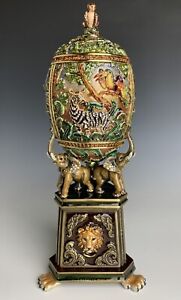
RARE Jay Strongwater Exotic Safari Egg w/ Base Elephant Monkey Lion Tiger
Click here for more information
CollectionHero
eBay RARE Jay Strongwater Exotic Safari Egg w/ Base Elephant Monkey Lion Tiger. (Condition: New (Other))
from CollectionHero
CollectionHero
5000.00
USD
2025-11-20
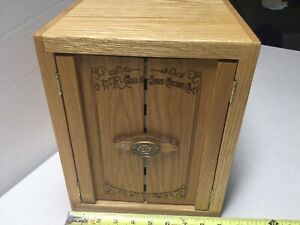
Case XX 2010 Tang Stamp 35 Knife Set #74 Of 200 Sets Ever Made Rare Set In Case
Click here for more information
CollectionHero
This Set of Case XX Tang Stamp Knives has 35 Knives in it,and is Limited to 200 Sets this Being #74 as Each Knife Blade has a #74 on it. In Original Wood Display Case from WR Case Bradford Pa. Case XX Tang Stamp Commemorative Set Tang Stamp Premier 35 pc Knife Set includes Case Bradford Era 1905-1920 Molasses Saw Bone Elephant’s Toe (6250 SS) ,Red Stag Large Texas Toothpick (R510098 SS),Rogers Jigged Old Red Bone Whittler (6383WH SS), Paula Mini Copperhead (82109X SS), Second Cut Jigged Black Bone Peanut (6220 SS), Case Tested Era 1920-1940 Walnut Saw Bone Large Swell Center Jack (C61050 SS),Burnt Stag Bareheaded Slimline Trapper (51048 SS),Rogers Jiggered Old Red Bone Razor (62005RAZ SS) Abalone Humpback Stockman (83046 SS),Standard Jiggered Goldenrod Bone Small Texas Toothpick (610096 SS), Case XX Era 1940-1964 Pale Honey Brown Saw Bone Large Saddlehorn (62100 SS),Corn Cob Jigged Brown Bone Large Stockman (6375 SS),Peach Seed Jigged Hunter Green Bone Muskrat (Muskrat SS),Vintage Stag Mini CopperLock R (V51749L SS), Himalayan Rams Horn Eisenhower (0EX263 SS) Case XX USA Era 1965-1969 Mediterranean Blue Saw Bone Folding Hunter (6265 SS) Second Cut Stag r Stockman (5347 SS), Rogers Jigged Dark Molasses Bone Canoe (62131 SS),Abalone Mini Trapper (8207 SS),Standard Jigged Tested Red Bone Cheetah Cub r (611 1/2 L SS), Case “Dot” Era 1970-1999 Dark Antique Saw Bone Clasp (6172 SS), SS), Genuine Mother-Of-Pearl Medium Stockman(8318 SS),Smooth Bermuda Green Bone Medium Congress (64052 SS), Red Stag Barlow (R52009 1/2 SS), Corn Cob Jigged Blue Lagoon Bone Tiny Trapper (62154 SS), Case “Dot’s-X,s Era 2000-2009 Black Saw Bone Grand Daddy Barlow(6143 SS), Rogers Corn Cob Jigged Kentucky Bluegrass Bone Trapper (6254 SS) XX Prime Stag RussLock r (51953L SS), Peach Seed Jigged Burnt Oatmeal Bone Saddlehorn (TB62165 SS), Second Cut Jiggered Cabernet Bone Pocket Hunter (TH62165 SS), Case X’s and Dot’s Era (2010-2019 Emerald Green Saw Bone Cigar Whittler (6391WH SS), Standard Jiggered Sunburst Bone TrapperLock (6154L SS), Mammoth Ivory Sway Back Gent (TBI1117 SS), Standard Jigged Jade Bone Small Gunstock (6215 SS), Himalayan Rams Horn Small Stockman (EX333 SS), This Is A 2010 Year Knife Set #74 of Only 200 Made Photos Are From Actual Knife Set. Great Collector’s Set You Could Drive A Set Of Steel Belted Tires Off Your Truck Looking For Another Great Gift For The Knife Collector In Your Life. This is the largest limited Edition Set Case Makes. Will Ship Priority Mail with Insurance and Signature. (Condition: Brand New)
from CollectionHero
CollectionHero
4999.00
USD
2025-11-20

Case XX 2010 Tang Stamp 35 Knife Set #74 Of 200 Sets Ever Made Rare Set In Case
Click here for more information
CollectionHero
eBay This Set of Case XX Tang Stamp Knives has 35 Knives in it,and is Limited to 200 Sets this Being #74 as Each Knife Blade has a #74 on it. In Original Wood Display Case from WR Case Bradford Pa. Case XX Tang Stamp Commemorative Set Tang Stamp Premier 35 pc Knife Set includes Case Bradford Era 1905-1920 Molasses Saw Bone Elephant’s Toe (6250 SS) ,Red Stag Large Texas Toothpick (R510098 SS),Rogers Jigged Old Red Bone Whittler (6383WH SS), Paula Mini Copperhead (82109X SS), Second Cut Jigged Black Bone Peanut (6220 SS), Case Tested Era 1920-1940 Walnut Saw Bone Large Swell Center Jack (C61050 SS),Burnt Stag Bareheaded Slimline Trapper (51048 SS),Rogers Jiggered Old Red Bone Razor (62005RAZ SS) Abalone Humpback Stockman (83046 SS),Standard Jiggered Goldenrod Bone Small Texas Toothpick (610096 SS), Case XX Era 1940-1964 Pale Honey Brown Saw Bone Large Saddlehorn (62100 SS),Corn Cob Jigged Brown Bone Large Stockman (6375 SS),Peach Seed Jigged Hunter Green Bone Muskrat (Muskrat SS),Vintage Stag Mini CopperLock R (V51749L SS), Himalayan Rams Horn Eisenhower (0EX263 SS) Case XX USA Era 1965-1969 Mediterranean Blue Saw Bone Folding Hunter (6265 SS) Second Cut Stag r Stockman (5347 SS), Rogers Jigged Dark Molasses Bone Canoe (62131 SS),Abalone Mini Trapper (8207 SS),Standard Jigged Tested Red Bone Cheetah Cub r (611 1/2 L SS), Case “Dot” Era 1970-1999 Dark Antique Saw Bone Clasp (6172 SS), SS), Genuine Mother-Of-Pearl Medium Stockman(8318 SS),Smooth Bermuda Green Bone Medium Congress (64052 SS), Red Stag Barlow (R52009 1/2 SS), Corn Cob Jigged Blue Lagoon Bone Tiny Trapper (62154 SS), Case “Dot’s-X,s Era 2000-2009 Black Saw Bone Grand Daddy Barlow(6143 SS), Rogers Corn Cob Jigged Kentucky Bluegrass Bone Trapper (6254 SS) XX Prime Stag RussLock r (51953L SS), Peach Seed Jigged Burnt Oatmeal Bone Saddlehorn (TB62165 SS), Second Cut Jiggered Cabernet Bone Pocket Hunter (TH62165 SS), Case X’s and Dot’s Era (2010-2019 Emerald Green Saw Bone Cigar Whittler (6391WH SS), Standard Jiggered Sunburst Bone TrapperLock (6154L SS), Mammoth Ivory Sway Back Gent (TBI1117 SS), Standard Jigged Jade Bone Small Gunstock (6215 SS), Himalayan Rams Horn Small Stockman (EX333 SS), This Is A 2010 Year Knife Set #74 of Only 200 Made Photos Are From Actual Knife Set. Great Collector’s Set You Could Drive A Set Of Steel Belted Tires Off Your Truck Looking For Another Great Gift For The Knife Collector In Your Life. This is the largest limited Edition Set Case Makes. Will Ship with Insurance. (Condition: Brand New)
from CollectionHero
CollectionHero
4999.00
USD
2025-11-20
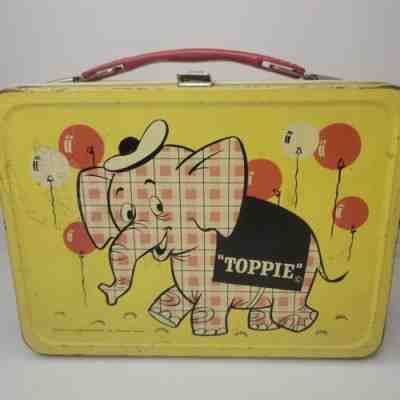
Toppie The Elephant Tin Lunch Box ORIGINAL 1957 Lunchbox RARE Kroger Promotion
Click here for more information
CollectionHero
Find many great new & used options and get the best deals for Toppie The Elephant Tin Lunch Box ORIGINAL 1957 Lunchbox RARE Kroger Promotion at the best online prices at eBay! Free shipping for many products!
from CollectionHero
CollectionHero
4799.99
USD
2025-11-20
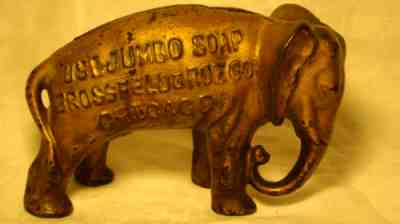
Super Rare "USE JUMBO SOAP" Cast Iron Elephant Bank Grossfeld & Roe Chicago 1850
Click here for more information
CollectionHero
Find many great new & used options and get the best deals for Super Rare "USE JUMBO SOAP" Cast Iron Elephant Bank Grossfeld & Roe Chicago 1850 at the best online prices at eBay! Free shipping for many products!
from CollectionHero
CollectionHero
4550.00
USD
2025-11-20
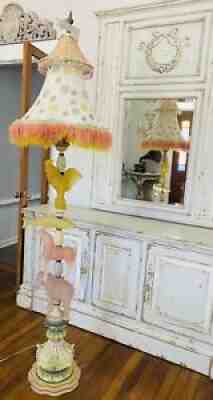
Mackenzie Childs Floor Lamp Rooster Chicken Fabulous RARE
Click here for more information
CollectionHero
Mackenzie Childs Floor Lamp Rooster horse Fish Chicken Fabulous RARE!Whimsical floor lamp has full figural molded resin animals including a horse, elephant, fish and rooster with a dog finial! Measures just over 6 feet Tall. I can ship but will have to have professionally packed at ups store so canâ??t quote a price until I take it there with winners address! Very rare, made my the original Mackenzie Hilda husband and wife team and o my a few of these were made! Mint condition!This can be picked up orWe can make arrangements to have it shipped!
from CollectionHero
CollectionHero
4500.00
USD
2025-11-20
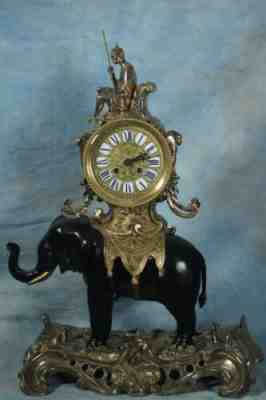
Antique Large Rare French Bronze Elephant Rider Clock 19th Century
Click here for more information
CollectionHero
Fine and heavy bronze clock on a famous and highly desirable motif. Such French clocks depicting elephant riders often grace museums throughout the world, they are in very high demand. The bronze of this clock is quite tarnished, especially its base and the rider.
from CollectionHero
CollectionHero
4500.00
USD
2025-11-20
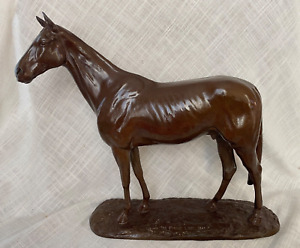
Rare 1932 Louis Paul Jonas (1894-1971) Bronze Statue of Race Horse Phar Lap
Click here for more information
CollectionHero
eBay This amazing bronze statue of the legendary horse Phar Lap was made by Louis Paul Jonas, one of the nations foremost wildlife sculptors. It is dated 1932 which makes it a rare, very early work by the artist. It was made at the Roman Bronze Works Foundry, as indicated by stamp on base. Jones' works are held in many important museums around the world - including the taxidermy model of Phar Lap that is on display at Melbourne Museum, and this same bronze is in the collection of the Australian Racing Museum!This majestic piece is aprox 15" tall and 14" long and on a base that is 5" wide. It weighs over 23 pounds and is marked 1926 Phar Lap 1932 and Louis Paul Jonas 1932. It is in excellent condition. Thank you, enjoy! From the internet "Phar Lap was a champion Australasian Thoroughbred racehorse. Achieving incredible success during his distinguished career, his initial underdog status gave people hope during the early years of the Great Depression. He won the Melbourne Cup, two Cox Plates, the Australian Derby, and 19 other weight-for-age races"."Louis Paul Jonas was a master sculptor, taxidermist, and exhibit designer who made many groundbreaking contributions in all of these fields. Among these contributions, he was the first person work with a leading paleontologist to sculpt anatomically correct, life size dinosaurs; he developed an innovative way to mount elephants for taxidermy exhibits, and he transformed exhibit design by creating lightweight fiberglass shells on which backgrounds were painted. From his work on the Akely Hall at the American Museum of Natural History in the 1920's to his 9 life-size dinosaurs sailing down the Hudson River on a barge destined for the 1960's Worlds Fair, Jonas' accomplishments touched millions of people. He is truly one of America's most talented artists." (Condition: Pre-Owned)
from CollectionHero
CollectionHero
4252.00
USD
2025-11-20

VERY RARE ASSYRIAN BLACK STONE PLAQUE DEPICTING A SCENE WITH FIGURES AND ANIMALS
Click here for more information
CollectionHero
Amazing assyrian stone plaque depicting two figures and animals such as elephant and probably moneys
from CollectionHero
CollectionHero
4238.03
USD
2025-11-20
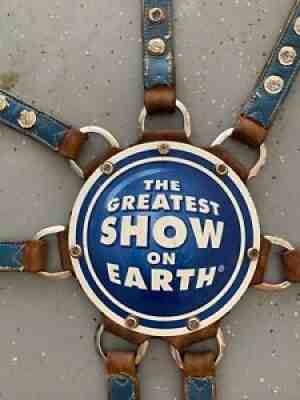
AUTHENTIC RINGLING BROS. BARNUM BAILEY Elephant Head dress rare the real deal!
Click here for more information
CollectionHero
Authentic Elephant Head dress from the Ringling Show in used condition. This is the real deal. leather is in superb shape and can be easily reconditioned by new owner.
from CollectionHero
CollectionHero
4199.00
USD
2025-11-20
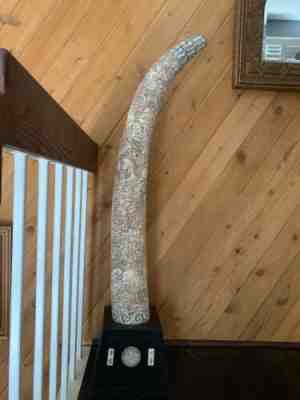
RARE PAIR aceh bovine bone REPLICA ELEPHANT TUSK Asian carved Pillars
Click here for more information
CollectionHero
On black painted wood bases 10â? long x 10â? wide x 7â? tall. pair of elephant tusks on wood bases. This is a very rare replica.
from CollectionHero
CollectionHero
3999.00
USD
2025-11-20
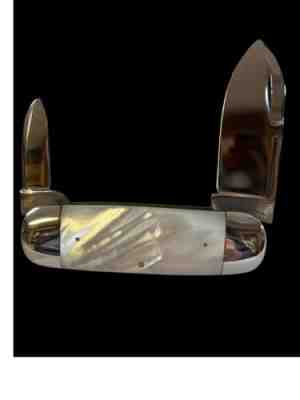
RARE CASE BROS LITTLE VALLEY NEW YORK PEARL ELEPHANT TOE HTF
Click here for more information
CollectionHero
Find many great new & used options and get the best deals for RARE CASE BROS LITTLE VALLEY NEW YORK PEARL ELEPHANT TOE HTF at the best online prices at eBay! Free shipping for many products!
from CollectionHero
CollectionHero
3495.95
USD
2025-11-20
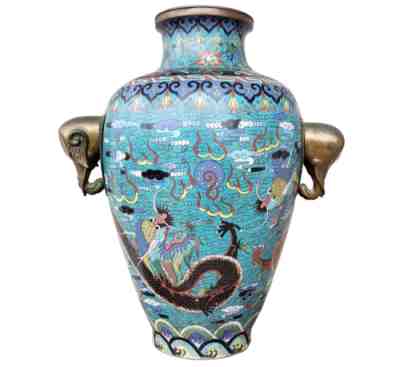
Large Rare Dragon Elephant Antique Cloisonne Chinese Flaming Pearl Enamel Vase
Click here for more information
CollectionHero
Rare Antique Early 20th Century Handled Chinese Cloisonné Vessel with Dragon Motif Featuring a pair of five-clawed dragons around a flaming pearl around clouds. Despite all of this, the piece displays well.
from CollectionHero
CollectionHero
3230.00
USD
2025-11-20